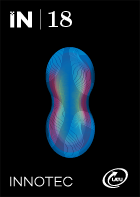Impact evaluation of new drillings in the Guarani Aquifer System on the set of operating wells in the cities of Concordia and Salto
DOI:
https://doi.org/10.26461/18.04Keywords:
Groundwater mathematical model, Well management, ModelMuseAbstract
The Guaraní Aquifer System (SAG), which includes parts of Brazil, Argentina, Paraguay, and Uruguay, is one of the largest reservoirs of fresh water in the world. Near the city of Concordia and Salto, the aquifer is confined by proximally a kilometer of basalts and is exploited for recreational use. In this context, a groundwater water model was created for this area, which comprises 15 wells, based on previous regional and local studies. Also, the geological model was updated by considering new drilling information and geophysical studies.
During the calibration process, fixed contour levels, compatible with regional piezometry, conductivity and specific storage values were estimated, in a way that the history of the piezometry variation was recreated. As a result, a mathematical model capable of reproducing the SAG behavior in the study area was generated. Through the model, an impact map for new wells drilling was created which can be used by the regulatory bodies for well permits in Argentina and Uruguay to evaluate the impact of new drillings.
Downloads
References
Gamazo, P., Ramos, J., Olivera, M., Sapriza, G., Batista, L., Lacués, X. y Manganelli, A., 2016. Modelo matemático del Acuífero Guaraní para la gestión de explotaciones termales en la zona de Concordia (Entre Ríos, Argentina) y Salto (Uruguay). En: IX Congreso Argentino de Hidrogeología y VII Seminario Hispano-Latinoamericano Sobre Temas Actuales de la Hidrología Subterránea. San Fernando del Valle, Argentina (20-23 de setiembre de 2016). San Fernando del Valle: [s.n.]
Poeter, E.P., Hill, M.C., Banta, E.R., Mehl, Steffen y Chris-tensen, Steen, 2005. UCODE_2005 and six other computer codes for universal
sensitivity analysis, calibration, and uncertainty evaluation constructed using the JUPITER API [En línea]. Washington: USGS. (Techniques and Methods, 6-A11). [Consulta: 21 de mayo de 2019]. Disponible en: http://pubs.er.usgs.gov/usgspubs/tm/tm6A11.
Proyecto SAG, 2008a. Avances en el conocimiento del Sistema Acuífero Guaraní: tomo 1. Geología y geofísica (regional y áreas piloto) Volumen 1 y Tomo 5. Modelos numéricos hidrogeológicos [En línea]. Montevideo: CeReGAS. [Consulta: 10 de abril de 2019] Disponible en: http://www.ceregas.org/publicaciones/proteccion-ambiental-y-desarrollo-sostenible-del-sistema-acuifero-guarani-sag/.
Proyecto SAG, 2008b. Avances en el conocimiento del sistema Acuífero Guaraní: Tomo 4. Climatología, hidrología e hidrogeología Volumen 4 [En línea]. Montevideo: CeReGAS. [Consulta: 10 de abril de 2019] Disponible en: http://www.ceregas.org/publicaciones/proteccion-ambiental-y-desarrollo-sostenible-del-sistema-acuifero-guarani-sag/.
Ramos, J., Gamazo, P. y Saracho, A., 2015a. Campaña de sondeos magnetotelúricos (AMT-MT) para el estudio geofísico profundo en Salto. Informe inédito. Departamento del Agua, CenUR Litoral Norte, sede Salto.
Ramos, J., Gamazo, P. y Saracho, A., 2015b. Realización de sondeos audio-magnetotelúricos en la cuenca del río Cuareim y elaboración de mapa piezométrico en las ciudades de Artigas y Quaraí. Informe inédito. Departamento del Agua, CenUR Litoral Norte, sede Salto.
Ramos, J., de Souza, R., Blanco, C., Saravia, C., Betancur, O., Ferreira, Á. y de los Santos, J., 2015c. Utilización de la energía geotérmica para calefacción de invernaderos. Informe inédito. Departamento del Agua, CenUR Litoral Norte, sede Salto.
Ramos, J., de Los Santos, J., Gamazo y P. Saracho, A., 2018. Campaña sondeos magnetotelúricos Gobernador Mansilla, Entre Ríos, Argentina. Informe inédito. Departamento del Agua, CenUR Litoral Norte, sede Salto.
Todd, D.K., 1980. Groundwater hydrology. 2nd ed. New York: John Wiley & Sons. 535p.
USGS, 2017. ModelMuse: a graphical user interface for groundwater models [En línea]. Versión 3.9. Washington: USGS. [Consulta: 10 de abril de 2019]. Disponible en: https://www.usgs.gov/software/modelmuse-a-graphical-user-interface-groundwater-models.
Published
How to Cite
Issue
Section
License
Copyright (c) 2019 Pablo Rafael Banega Grassi, Pablo Gamazo, Julián Andrés Ramos, Vanessa Erasun, Gonzalo Sapriza, Lucas Bessone

This work is licensed under a Creative Commons Attribution-NonCommercial 4.0 International License.
Los autores del manuscrito declaran conocer y aceptar los siguientes términos de responsabilidad:
Haber participado lo suficiente en el trabajo como para hacer pública la responsabilidad por su contenido.
Que el manuscrito representa un trabajo original que no fue publicado ni está siendo considerado por otra revista para su publicación, en parte o en forma íntegra, tanto impresa como electrónica.
Que en caso de ser solicitado, procurará o cooperará en la obtención y suministro de datos sobre los cuales el manuscrito esté basado.
Declara que la información divulgada que pudiera pertenecer a un tercero cuenta con la autorización correspondiente.
Autorización para la publicación y compromiso de cita de primera publicación
Los autores/as conservan los derechos de autor y ceden a la revista INNOTEC / INNOTEC Gestión el derecho de la primera publicación, con el trabajo registrado con la licencia de atribución Creative Commons Reconocimiento-NoComercial 4.0 Internacional. Creative Commons, que permite a terceros utilizar lo publicado siempre que mencionen la autoría del trabajo y a la primera publicación en esta revista sin fines comerciales.
El autor se compromete a realizar la cita completa de la edición institucional de esta primer publicación en las siguientes publicaciones -completas o parciales- efectuadas en cualquier otro medio de divulgación, impreso o electrónico.
Los autores/as pueden realizar otros acuerdos contractuales no comerciales independientes y adicionales para la distribución no exclusiva de la versión del artículo publicado en esta revista (p. ej., incluirlo en un repositorio institucional o publicarlo en un libro) siempre que indiquen claramente que el trabajo se publicó por primera vez en esta revista.
Se permite a los autores/as publicar su trabajo en Internet (por ejemplo en páginas institucionales o personales) antes y durante el proceso de revisión, ya que puede conducir a intercambios productivos y a una mayor y más rápida difusión del trabajo publicado (vea The Effect of Open Access). A su vez los autores/as autorizan al LATU a publicar el trabajo en su repositorio digital.
Los conceptos y opiniones vertidos en los artículos son de responsabilidad de sus autores.
Este obra está bajo una licencia Reconocimiento-NoComercial 4.0 Internacional.












